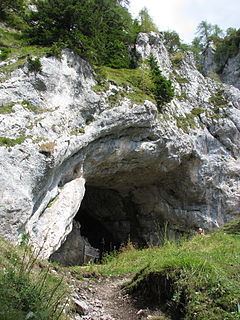Length 115 m (377 ft) | Width 40 m (130 ft) | |
 | ||
Potok Cave (Slovene: Potočka zijalka or Potočka zijavka) is a [[cave] in northern Slovenia, declared a high-elevation archaeological and paleontological site, occupied approximately 35,000 years BP (before present) by anatomically modern humans of the Aurignacian culture during the Upper Paleolithic. The cave is named after the Potok Farm in Podolševa, and the Slovene term zijalka or zijavka refers to a flat-bottomed cave with a gaping mouth on a cliff face. Systematic excavations were carried out by the Slovenian archaeologist Srečko Brodar.
Contents
Location
It is located in the eastern Karawanks in northern Slovenia, on the southern slope of Mount Olševa above Solčava, at an elevation of 1,675 m (5,495 ft) in the Triassic limestone. It is 115 m (377 ft) long and varies from 17 m (56 ft) wide at the mouth to 40 m (130 ft) wide in the interior. Its entry opens toward the south.
Role
There are two explanations of its role. According to the original explanation, the cave was a hunting station. According to the newer one, it was a ritual place.
Excavations
After amateur excavations by Josef Gross, a medical student from Austria, the area was bought by Museum Society of Celje on behalf of which the systematic excavations were carried out by archaeologist Srečko Brodar, starting in 1928 and continuing until 1935.
The finds from eight layers excavated from the cave included the bones of over 40 animal species, including the cave bears, wolves, alpine marmots, hares, red foxes, weasels, lynx, red deer, chamois, and in particular, teeth of a muskox, as well as 123 arrowheads, a controversial bone flute, and one of the world's oldest sewing needles.
Exhibits
In a village near the location itself, a permanent exhibit is open for tourists at the Firšt Inn and Museum in the Logar Valley. The other finds can be seen at the Celje Regional Museum, where however much of the collection was destroyed during World War II in 1945 bombing raids.
